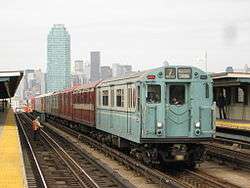Hi-V (New York City Subway car)
| Hedley Hi-V | |
|---|---|
| Manufacturer | Standard Steel, Pressed Steel Car Company, Pullman |
| Constructed | 1910-1911, 1915 |
| Scrapped | 1955-1960 |
| Number built | 617 |
| Number preserved | 0 |
| Number scrapped | 617 |
| Formation | Singles |
| Fleet numbers | 3700-4024, 4223-4514 |
| Operator(s) |
Interborough Rapid Transit Company NYC Board of Transportation New York City Transit Authority |
| Specifications | |
| Car body construction | Riveted Steel |
| Car length | 51 ft 1.5 in (15.58 m) |
| Width | 8 ft 10 in (2,692 mm) |
| Height | 12 ft 0 in (3,658 mm) |
| Doors |
Up until the early 1910s:4 After the 1910s:6 |
| Maximum speed | 55 mph (89 km/h) |
| Traction system | Motor car: 2 motors per car. |
| Power output | 200 hp (149 kW) per traction motor |
| Electric system(s) | 600 V DC Third rail |
| Current collection method | Top running Contact shoe |
| Braking system(s) |
Before 1910: WABCO Schedule AM(P) with 'P' type triple valve and M-2 brake stand After 1910: WABCO Schedule AMRE with 'R' type triple valve and ME-21 brake stand |
| Track gauge | 4 ft 8 1⁄2 in (1,435 mm) |
The Hedley Hi-V, a New York City Subway car, was built between 1910 and 1911, which were motor cars and then in 1915 an order for trailers that were numbered 4223-4514. These were the first cars built with center doors. They were also the last high voltage cars built for the system as all subway cars delivered afterward had low voltage since high voltage cars were a hazard to both the train operators and track crews, which is probably one of a few reasons why the TA was in a rush to get rid of these cars by the mid 1950s with the R17, R21, and R22 cars.
Service history
These cars ran on both the West Side and Broadway-7th Ave lines and ran with both the Gibbs and Deckroof Hi-V cars until they retired by 1959 along with what was left of both the Hi-V Gibbs and Hi-V Deckroofs, which were in very small numbers by that point.[1] Several cars were used in work service until 1960-1961 before getting scrapped. Cars 3712 and 3737 were used as welding cars. A fleet of cars numbered 4015-4024 operated on the Times Square shuttle line. [2] The Hedley's standard car body would be incorporated into another fleet of cars known as the Lo-V fleet, which were built from 1915 to 1925. None of the Hedleys were saved, as it was not thought of at the time to preserve for future generations.
Hi-V Specifications
- Car Builder: Pressed Steel Car Company, American Car and Foundry, Standard Steel
- Car Body:
- Unit Numbers: 3700-4024, 4223-4514
- Fleet: 617 cars
- Car Length: 51 feet 1.5 inches (15.58 m)
- Car Width: 8 feet 10 inches (2.69 m)
- Car Height: 12 feet (3.66 m)
- Track Gauge: 4 ft 8 1⁄2 in (1,435 mm)
- Propulsion System: WH/GE C18
- Motors (2 per motor truck): GE 69, 212, WH 86, 300
- Power: 200 hp (149 kW) per motor
- Total Seating: 44
- Total Weight: 77,500 lb (35,150 kg) (3700-3756, 3815, 3915), 81,450 lb (36,945 kg) (3757-3814, 3816-3914, 3916-4024)
References
- ↑
- ↑ https://books.google.com/books?id=6WFHNSXBpocC&lpg=PA368&ots=8V9QFWySvR&dq=IRT%20GE%2069%20motors&pg=PA370#v=onepage&q=IRT%20GE%2069%20motors&f=true
External links
- http://nycsubway.org/cars/interborough_fleet.html
- http://nycsubway.org/articles/chiasson-irtfleet.html
- http://nycsubway.org/articles/theymovedthemillions2.html


